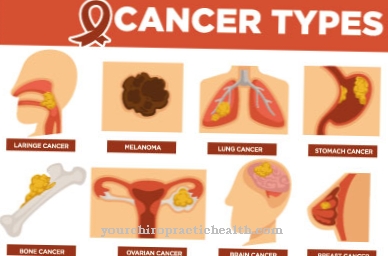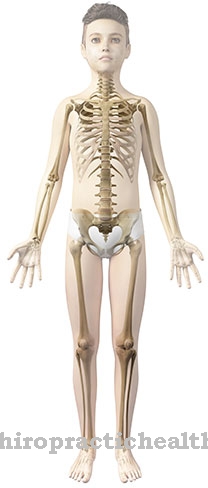The Peutz-Jeghers Syndrome is a hereditary disease characterized by the appearance of polyps of the gastrointestinal tract and pigment spots. The polyps can cause complications such as bleeding, intestinal obstruction, or intussusception. Those affected have an increased risk of cancer.
What is Peutz-Jeghers Syndrome?

© phonlamaiphoto - stock.adobe.com
The Peutz-Jeghers Syndrome is a disease in which numerous polyps of the gastrointestinal tract occur in combination with pigment spots on the skin and mucous membranes. The disease is inherited in an autosomal dominant manner. It is passed on to each of his children by a gene carrier with a probability of 50 percent.
The gender is not important. The syndrome occurs as a new mutation in half of the cases without a gene carrier as the parent. The disease is associated with an increased risk of cancer. It is named after the internists Jan Peutz and Harold Jeghers. The disease is synonymous as hamartomatous polyposis intestinalis, Hutchinson-Weber-Peutz syndrome, Lentiginosis polyposa Peutz or Peutz-Jeghers hamartosis designated.
The disease was first described by J. Hutchinson as early as 1896. With an estimated frequency of 1: 25,000 to 1: 280,000, the disease occurs rarely.
causes
The cause of the syndrome is a gene mutation. The serine threonine kinase STK 11 (also LKB 1) on chromosome 19p13.3 is affected. It is a tumor suppressor gene. If this is switched off by the mutation, an increased number of tumors will develop. The mutation of this gene could be detected in 70 percent of the patients with a positive family history. In those sporadically affected, it was found in 20 to 60 percent of the cases. It is believed that the mutation of other genes also triggers the disease.
Symptoms, ailments & signs
In Peutz-Jeghers syndrome, pigment spots on the skin and mucous membranes are noticeable. These arise mainly on the red lips, on the cheek mucosa and the skin surrounding the mouth. The skin on the nose, eyes, hands and feet can also be affected. The spots are at the skin level and are up to about one centimeter in size. They can be light brown to black. The pigment spots are either already present at birth or arise in the first years of life. In the course of life they can lighten.
Polyps occur in the gastrointestinal tract in around 88 percent of patients. They manifest themselves between the ages of 10 and 30. Several hundred of these benign tumors, between one and five millimeters in size, can develop. They are mainly found in the small and large intestines. The stomach and rectum are also often affected. In rare cases, polyps appear on the kidneys, lungs and bladder.
One symptom of Peutz-Jeghers syndrome is the intestinal obstruction, which is caused mechanically by the polyps. Colic abdominal pain, rectal bleeding, or bloody stools can also be symptoms. These can lead to anemia. Intussusception occurs repeatedly in patients with the syndrome. The small intestine is everted into the large intestine.
Diagnosis & course of disease
The diagnosis is mainly made on the basis of the clinical picture of pigment spots and polyps of the gastrointestinal tract and the family history. The clinical diagnosis can be confirmed by means of genetic diagnostics. Genetic diagnostics can also be carried out in clinically healthy people who are related to an affected person for the first time.
According to the Genetic Diagnostics Act, accompanying genetic counseling must be offered for this procedure. Additional psychotherapeutic care is recommended. Bleeding, intestinal obstruction and intussusception can be complicated and lead to death. Patients affected by intestinal polyposis have a risk of up to 90 percent of developing cancer during their lifetime.
The degeneration of polyps can lead to carcinomas of the gastrointestinal tract. The risk of developing tumors of the uterus, cervix, breast, ovaries, lungs, pancreas and testicles is also increased. A degeneration of the pigment spots is not known.
Complications
Because of the Peutz-Jeghers syndrome, those affected suffer from various ailments in the stomach and intestines. Polyps mainly occur, which can lead to severe pain and bleeding. The patients also suffer from an increased risk of cancer, so that the patient's life expectancy may also be reduced. Furthermore, the Peutz-Jeghers syndrome leads to pigment disorders, so that the patients have pigment spots on the skin.
In some cases, this can lead to inferiority complexes or reduced self-esteem. The skin itself is covered with spots, so that in many cases those affected no longer feel beautiful and are ashamed of the symptoms. More tumors occur in the intestine, which can lead to various complaints and furthermore to an intestinal obstruction. The patients also suffer from anemia and bloody stools.
Usually the polyps and tumors can be removed with a colonoscopy. There are no particular complications. However, the tumor may have already spread to other regions, so that cancer has also developed there. In this case, the life expectancy of the person affected is significantly reduced.
When should you go to the doctor?
The Peutz-Jeghers syndrome should always be examined and treated by a doctor. Only with early treatment and regular examinations can further complications be avoided. Since those affected by the Peutz-Jeghers syndrome also suffer from an increased risk of cancer, regular preventive examinations are very useful.
A doctor should be consulted in this syndrome if the patient frequently has reddened lips and spots on the skin that do not go away on their own and appear permanently. The symptoms can also appear in the early years, so prevention is particularly useful for children.
The Peutz-Jeghers syndrome can also lead to an intestinal obstruction, so that if you have severe abdominal pain, a doctor's visit is also necessary to examine it. In the case of anemia, permanent treatment is inevitable. The Peutz-Jeghers syndrome itself can in most cases be diagnosed by a general practitioner. However, further treatment depends largely on the exact symptoms, whereby regular preventive examinations are also very useful in order not to reduce the life expectancy of the patient.
Treatment & Therapy
A causal therapy is not possible. Treatment can only be symptomatic. Some polyps can lead to bleeding or degenerate. These should be removed as part of regular gastric and colonoscopies. It is not possible to remove all polyps.
If bleeding from a polyp occurs, this can be stopped by a colonoscopy or surgery, depending on the findings. If an operation is necessary, partial removal of the intestine may even be necessary in the case of complicated processes. In the case of heavy bleeding, it may be necessary to use blood reserves.
If intussusception occurs, surgery is usually unavoidable. The part of the small intestine that everts into the large intestine is threatened with death. The small intestine is withdrawn from the large intestine and fixed in its anatomically correct position. If parts of the intestine have already died, these must be removed.
The intestinal obstruction also requires surgical therapy. This removes the mechanical obstacle. Any dead intestinal parts are also removed during this operation. Cosmetically annoying pigment spots can be lightened or removed by means of laser treatment.
Outlook & forecast ana
The prospects for Peutz-Jeghers syndrome can only be assessed individually. It is an inherited gastrointestinal disease. This results in typical hemartomatous polyps. These are mainly found in the entire gastrointestinal tract.
Peutz-Jeghers polyps can also occur in other parts of the body. They can be recognized by a specific pigmentation. The problem is that the prognosis is difficult to assess because of the possible development of the polyps into malignant tumors.
The risks of developing cancerous ulcers are definitely increased significantly. It is therefore advisable to carry out regular examinations of the gastrointestinal tract. The attending physician decides how often these examinations should be carried out. So far, there is no knowledge of which monitoring strategies are most successful. It makes sense to remove as many polyps from the gastrointestinal tract as possible. The number of operations required is usually high in patients with Peutz-Jeghers syndrome.
In addition, intestinal obstruction and other complications should be corrected or prevented. These can arise from the polyps. In younger patients, it is enough to observe the development of the polyps in particular. Malignancies must be monitored in older people. The prognosis must be adjusted depending on how severe any complications from such polyps are. In elderly patients, a prognosis can only be made on the basis of the development of malignancies.
prevention
A precaution in the sense of preventing the outbreak of the disease is not possible. Gastric and colonoscopies should be performed at regular intervals to avoid complications and for early detection of degenerated polyps. Tests for the early detection of other cancers are also recommended.
Women should have regular pelvic exams and mammograms. Men are advised to have a regular urological presentation. First-degree relatives of those affected can have genetic diagnostics carried out. This only provides information about the genetic status and has no consequence for the course of the disease.
Aftercare
In most cases, the options for follow-up care for Peutz-Jeghers syndrome are very limited. Since this is a hereditary disease, it usually cannot be completely cured, so the patient should consult a doctor as soon as the first signs and symptoms appear.
As a rule, a doctor should also be consulted if you want to have children so that a genetic examination and advice can be carried out in order to prevent the recurrence of Peutz-Jeghers syndrome in the descendants.With this syndrome, those affected depend on regular visits to an internist in order to carry out a colonoscopy and detect damage or a tumor in the intestine very early on.
In many cases, an operation is necessary, after which those affected should definitely rest and take it easy. You should refrain from exertion or physical activity in order not to unnecessarily burden the body. Most of those affected are also dependent on the help and support of their own family in their everyday life, which can have a positive effect on the further course of the Peutz-Jeghers syndrome. This disease may also reduce the life expectancy of the person affected.
You can do that yourself
People who suffer from Peutz-Jeghers syndrome should first be examined and treated by a doctor, as the syndrome is a serious condition. In addition, there are self-help measures such as a healthy lifestyle and an open approach to the ailment.
If an intestinal invagination is suspected, the emergency doctor must be called. At the same time, the patient should regularly go to an early detection examination so that the breasts, gastrointestinal tract and other organs can be examined for polyps. If there is already a specific suspicion, for example in the case of pain or visible swelling, it is best to consult your family doctor immediately. Peutz-Jeghers syndrome can only be treated by a doctor, but the patient can support the treatment by examining the body for new complaints and keeping a complaint diary.
In addition, general measures help to improve well-being. In addition to exercise and a healthy diet, massages or acupuncture are also recommended. These measures should be discussed beforehand with the responsible doctor so that there are no complications. If the symptoms get worse or return after therapy, a doctor's visit is indicated.


.jpg)
























